Audit Procedures for Balance Sheet Items
VerifiedAdded on 2023/01/12
|11
|1746
|66
AI Summary
This document provides an overview of the audit procedures for balance sheet items such as accounts receivable, accounts payable, inventory, and fixed assets. It discusses the relevant assertions, audit strategy, test controls, and substantive approach. The document also includes a sample audit team and references for further reading.
Contribute Materials
Your contribution can guide someone’s learning journey. Share your
documents today.
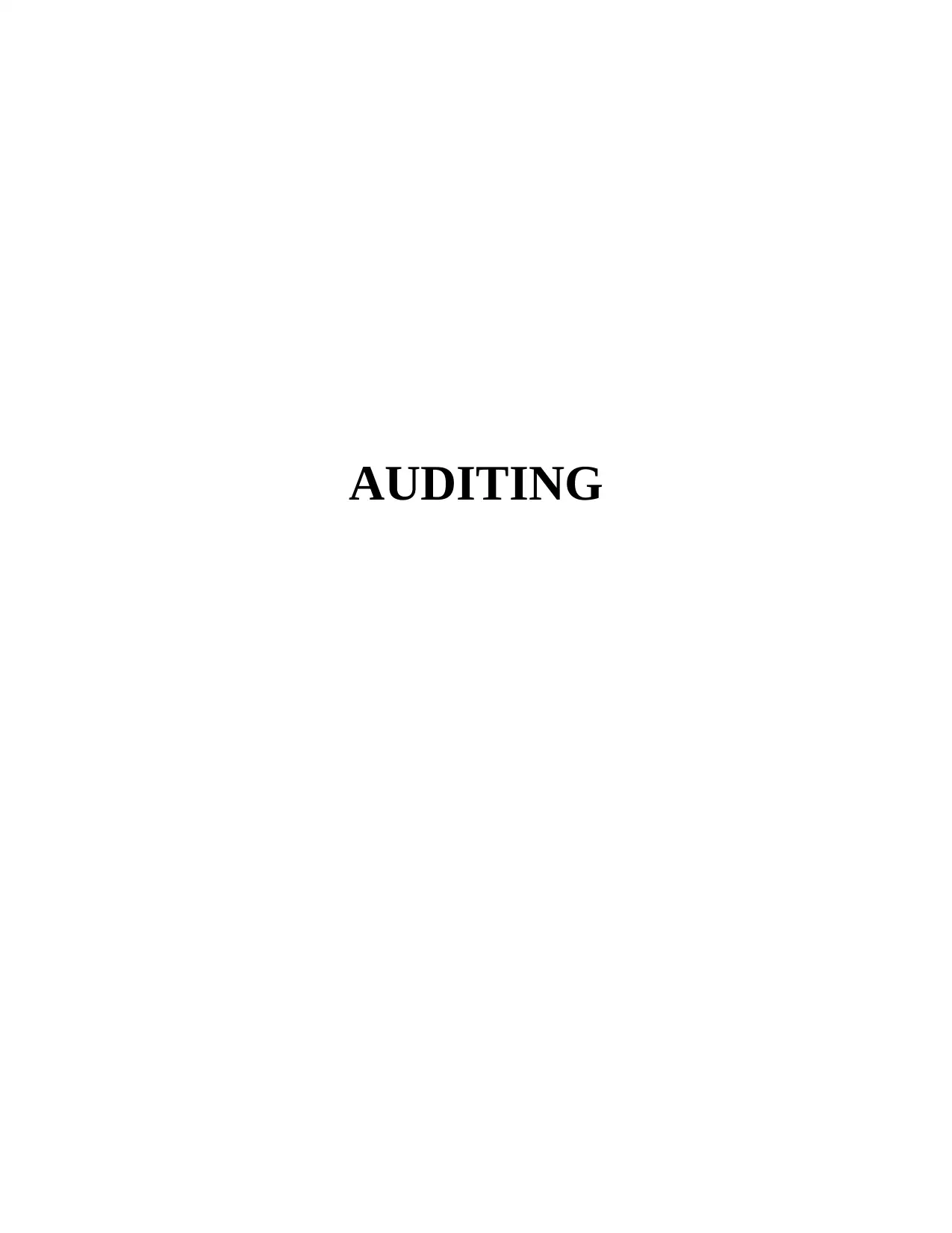
AUDITING
Secure Best Marks with AI Grader
Need help grading? Try our AI Grader for instant feedback on your assignments.
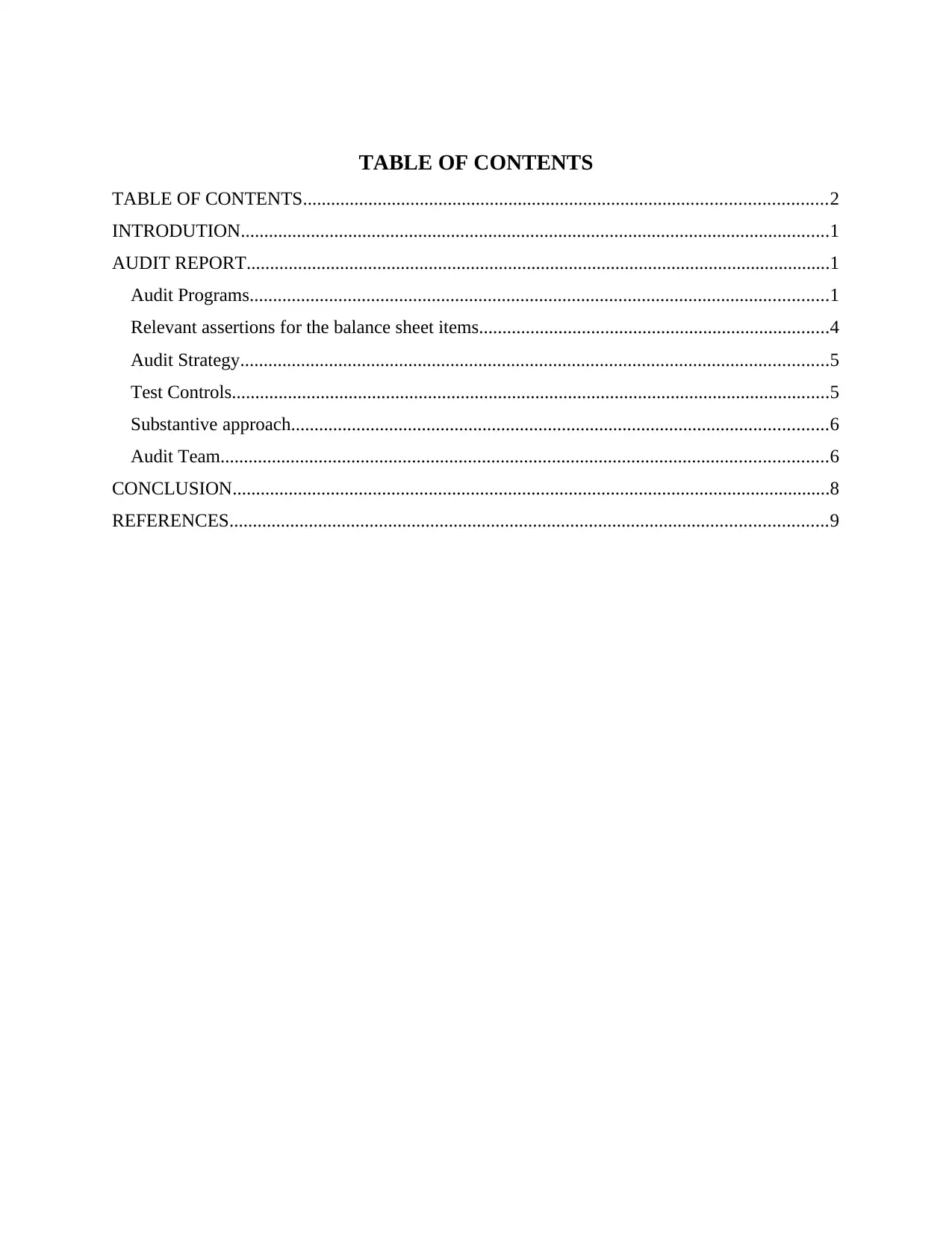
TABLE OF CONTENTS
TABLE OF CONTENTS................................................................................................................2
INTRODUTION..............................................................................................................................1
AUDIT REPORT.............................................................................................................................1
Audit Programs............................................................................................................................1
Relevant assertions for the balance sheet items...........................................................................4
Audit Strategy..............................................................................................................................5
Test Controls................................................................................................................................5
Substantive approach...................................................................................................................6
Audit Team..................................................................................................................................6
CONCLUSION................................................................................................................................8
REFERENCES................................................................................................................................9
TABLE OF CONTENTS................................................................................................................2
INTRODUTION..............................................................................................................................1
AUDIT REPORT.............................................................................................................................1
Audit Programs............................................................................................................................1
Relevant assertions for the balance sheet items...........................................................................4
Audit Strategy..............................................................................................................................5
Test Controls................................................................................................................................5
Substantive approach...................................................................................................................6
Audit Team..................................................................................................................................6
CONCLUSION................................................................................................................................8
REFERENCES................................................................................................................................9
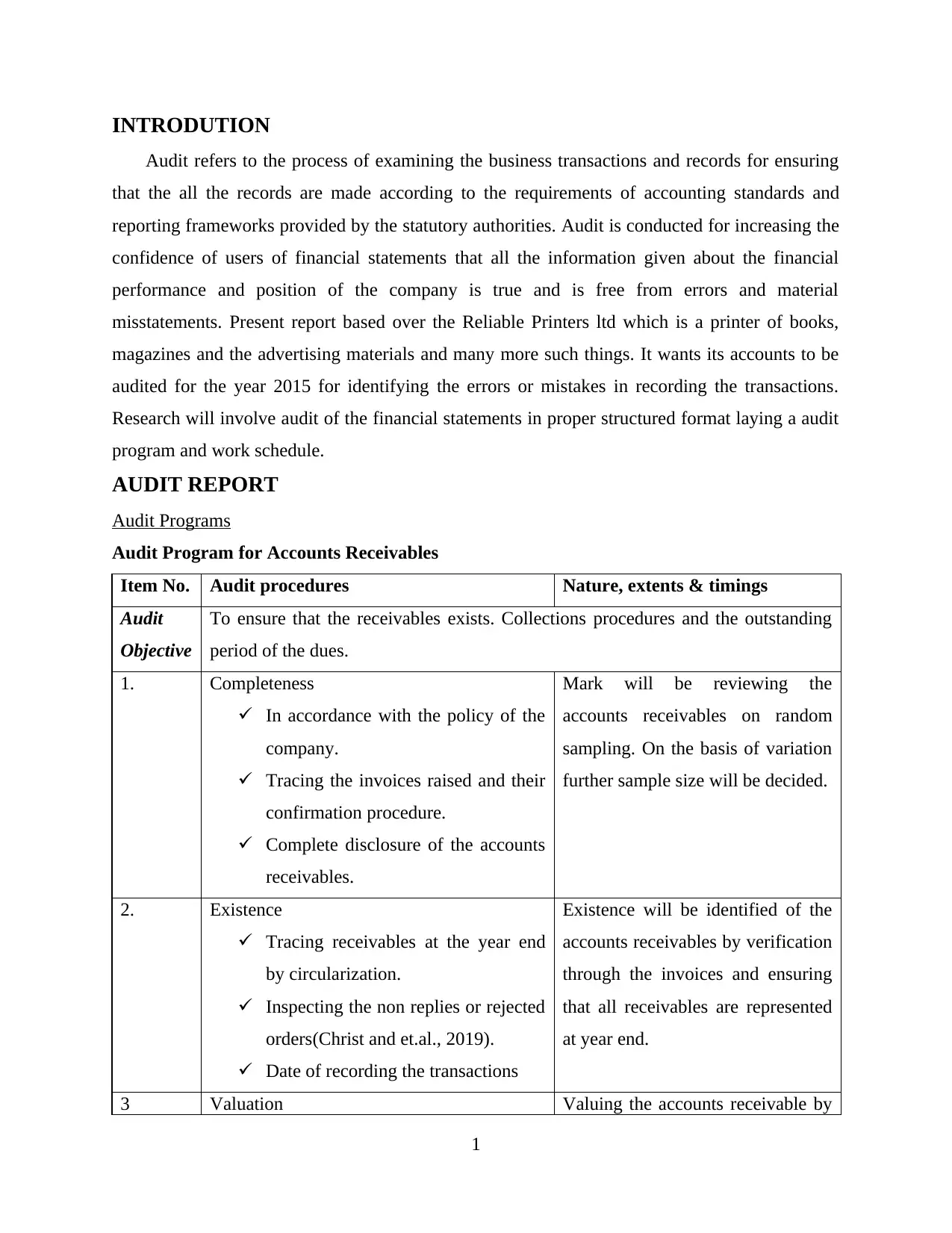
INTRODUTION
Audit refers to the process of examining the business transactions and records for ensuring
that the all the records are made according to the requirements of accounting standards and
reporting frameworks provided by the statutory authorities. Audit is conducted for increasing the
confidence of users of financial statements that all the information given about the financial
performance and position of the company is true and is free from errors and material
misstatements. Present report based over the Reliable Printers ltd which is a printer of books,
magazines and the advertising materials and many more such things. It wants its accounts to be
audited for the year 2015 for identifying the errors or mistakes in recording the transactions.
Research will involve audit of the financial statements in proper structured format laying a audit
program and work schedule.
AUDIT REPORT
Audit Programs
Audit Program for Accounts Receivables
Item No. Audit procedures Nature, extents & timings
Audit
Objective
To ensure that the receivables exists. Collections procedures and the outstanding
period of the dues.
1. Completeness
In accordance with the policy of the
company.
Tracing the invoices raised and their
confirmation procedure.
Complete disclosure of the accounts
receivables.
Mark will be reviewing the
accounts receivables on random
sampling. On the basis of variation
further sample size will be decided.
2. Existence
Tracing receivables at the year end
by circularization.
Inspecting the non replies or rejected
orders(Christ and et.al., 2019).
Date of recording the transactions
Existence will be identified of the
accounts receivables by verification
through the invoices and ensuring
that all receivables are represented
at year end.
3 Valuation Valuing the accounts receivable by
1
Audit refers to the process of examining the business transactions and records for ensuring
that the all the records are made according to the requirements of accounting standards and
reporting frameworks provided by the statutory authorities. Audit is conducted for increasing the
confidence of users of financial statements that all the information given about the financial
performance and position of the company is true and is free from errors and material
misstatements. Present report based over the Reliable Printers ltd which is a printer of books,
magazines and the advertising materials and many more such things. It wants its accounts to be
audited for the year 2015 for identifying the errors or mistakes in recording the transactions.
Research will involve audit of the financial statements in proper structured format laying a audit
program and work schedule.
AUDIT REPORT
Audit Programs
Audit Program for Accounts Receivables
Item No. Audit procedures Nature, extents & timings
Audit
Objective
To ensure that the receivables exists. Collections procedures and the outstanding
period of the dues.
1. Completeness
In accordance with the policy of the
company.
Tracing the invoices raised and their
confirmation procedure.
Complete disclosure of the accounts
receivables.
Mark will be reviewing the
accounts receivables on random
sampling. On the basis of variation
further sample size will be decided.
2. Existence
Tracing receivables at the year end
by circularization.
Inspecting the non replies or rejected
orders(Christ and et.al., 2019).
Date of recording the transactions
Existence will be identified of the
accounts receivables by verification
through the invoices and ensuring
that all receivables are represented
at year end.
3 Valuation Valuing the accounts receivable by
1
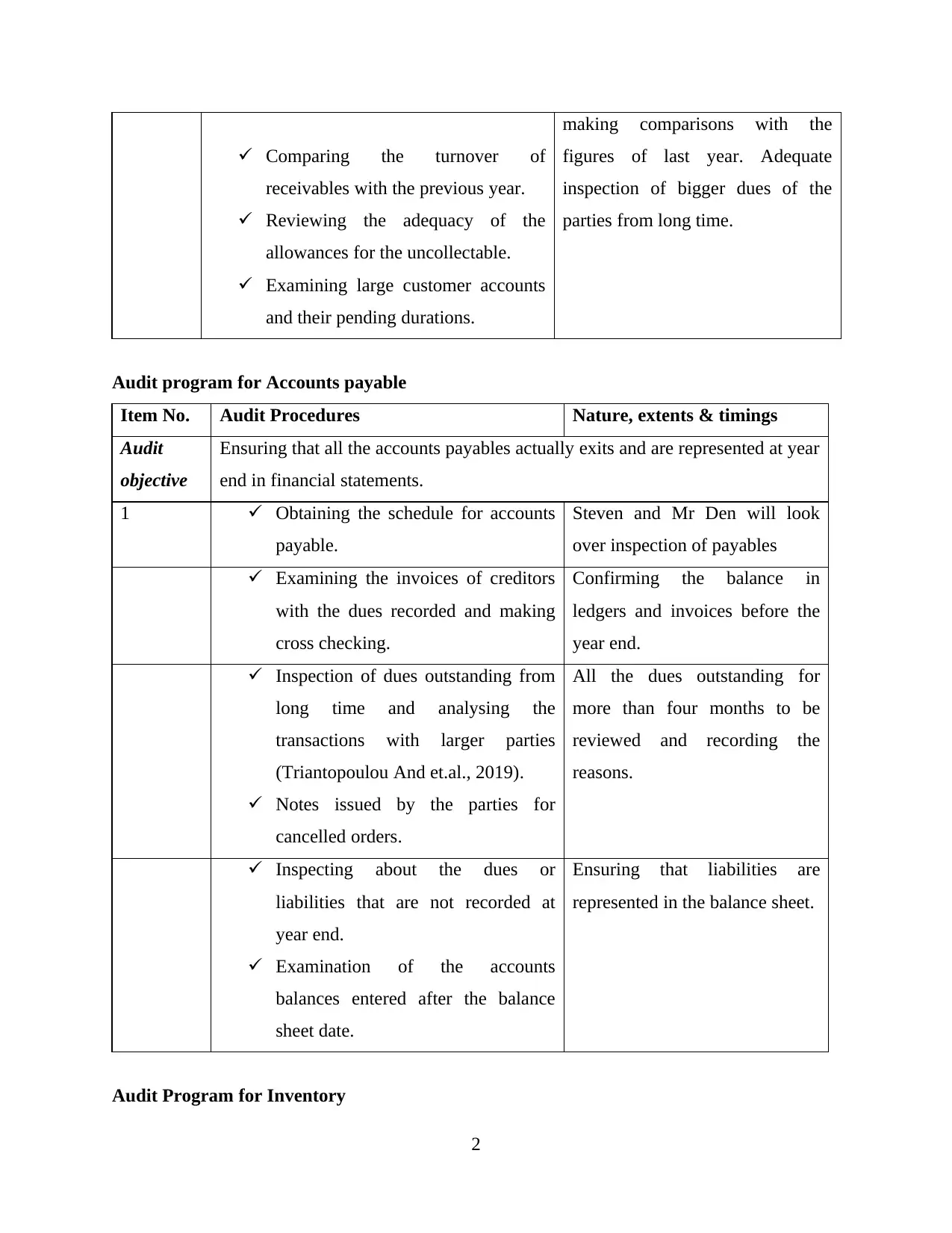
Comparing the turnover of
receivables with the previous year.
Reviewing the adequacy of the
allowances for the uncollectable.
Examining large customer accounts
and their pending durations.
making comparisons with the
figures of last year. Adequate
inspection of bigger dues of the
parties from long time.
Audit program for Accounts payable
Item No. Audit Procedures Nature, extents & timings
Audit
objective
Ensuring that all the accounts payables actually exits and are represented at year
end in financial statements.
1 Obtaining the schedule for accounts
payable.
Steven and Mr Den will look
over inspection of payables
Examining the invoices of creditors
with the dues recorded and making
cross checking.
Confirming the balance in
ledgers and invoices before the
year end.
Inspection of dues outstanding from
long time and analysing the
transactions with larger parties
(Triantopoulou And et.al., 2019).
Notes issued by the parties for
cancelled orders.
All the dues outstanding for
more than four months to be
reviewed and recording the
reasons.
Inspecting about the dues or
liabilities that are not recorded at
year end.
Examination of the accounts
balances entered after the balance
sheet date.
Ensuring that liabilities are
represented in the balance sheet.
Audit Program for Inventory
2
receivables with the previous year.
Reviewing the adequacy of the
allowances for the uncollectable.
Examining large customer accounts
and their pending durations.
making comparisons with the
figures of last year. Adequate
inspection of bigger dues of the
parties from long time.
Audit program for Accounts payable
Item No. Audit Procedures Nature, extents & timings
Audit
objective
Ensuring that all the accounts payables actually exits and are represented at year
end in financial statements.
1 Obtaining the schedule for accounts
payable.
Steven and Mr Den will look
over inspection of payables
Examining the invoices of creditors
with the dues recorded and making
cross checking.
Confirming the balance in
ledgers and invoices before the
year end.
Inspection of dues outstanding from
long time and analysing the
transactions with larger parties
(Triantopoulou And et.al., 2019).
Notes issued by the parties for
cancelled orders.
All the dues outstanding for
more than four months to be
reviewed and recording the
reasons.
Inspecting about the dues or
liabilities that are not recorded at
year end.
Examination of the accounts
balances entered after the balance
sheet date.
Ensuring that liabilities are
represented in the balance sheet.
Audit Program for Inventory
2
Secure Best Marks with AI Grader
Need help grading? Try our AI Grader for instant feedback on your assignments.
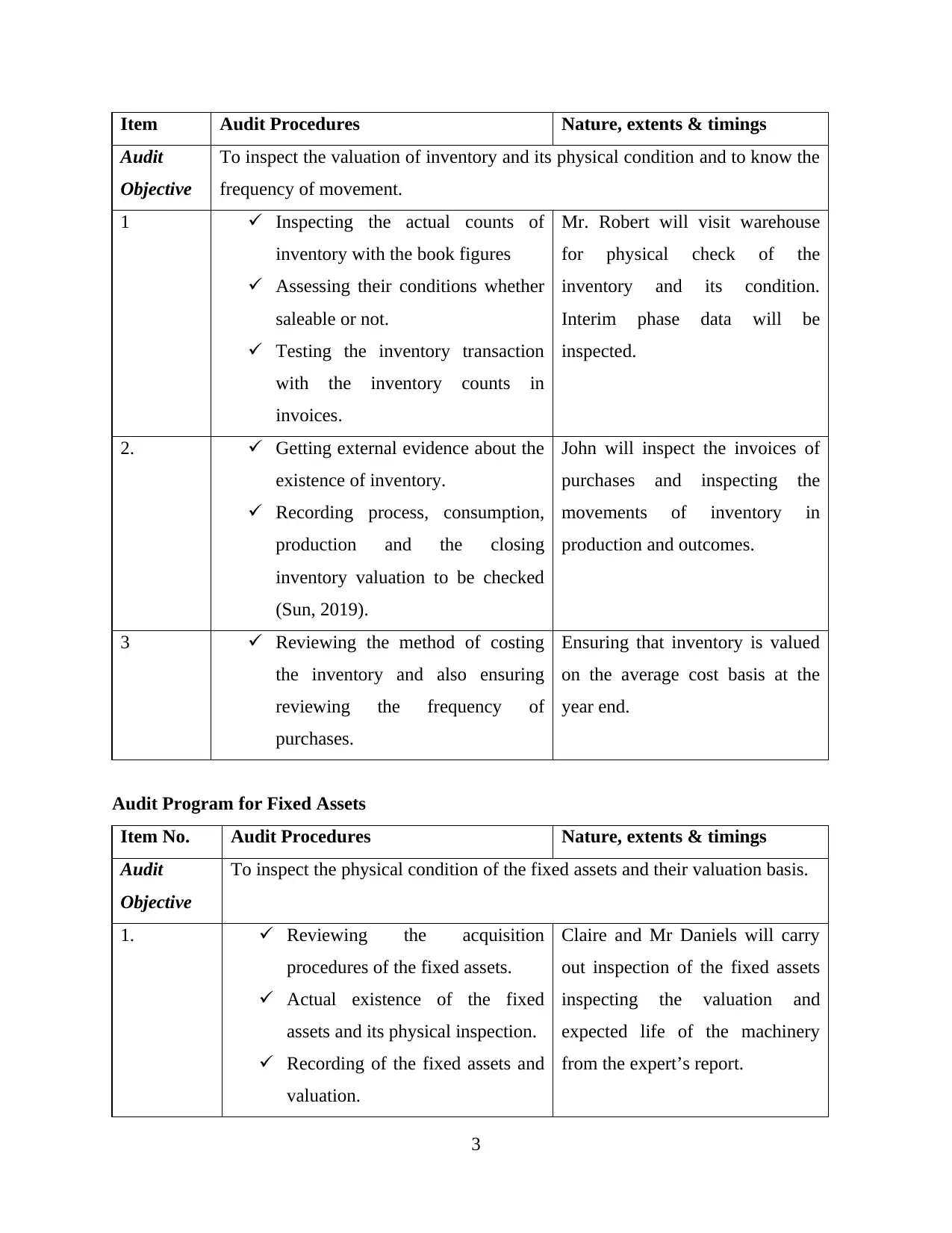
Item Audit Procedures Nature, extents & timings
Audit
Objective
To inspect the valuation of inventory and its physical condition and to know the
frequency of movement.
1 Inspecting the actual counts of
inventory with the book figures
Assessing their conditions whether
saleable or not.
Testing the inventory transaction
with the inventory counts in
invoices.
Mr. Robert will visit warehouse
for physical check of the
inventory and its condition.
Interim phase data will be
inspected.
2. Getting external evidence about the
existence of inventory.
Recording process, consumption,
production and the closing
inventory valuation to be checked
(Sun, 2019).
John will inspect the invoices of
purchases and inspecting the
movements of inventory in
production and outcomes.
3 Reviewing the method of costing
the inventory and also ensuring
reviewing the frequency of
purchases.
Ensuring that inventory is valued
on the average cost basis at the
year end.
Audit Program for Fixed Assets
Item No. Audit Procedures Nature, extents & timings
Audit
Objective
To inspect the physical condition of the fixed assets and their valuation basis.
1. Reviewing the acquisition
procedures of the fixed assets.
Actual existence of the fixed
assets and its physical inspection.
Recording of the fixed assets and
valuation.
Claire and Mr Daniels will carry
out inspection of the fixed assets
inspecting the valuation and
expected life of the machinery
from the expert’s report.
3
Audit
Objective
To inspect the valuation of inventory and its physical condition and to know the
frequency of movement.
1 Inspecting the actual counts of
inventory with the book figures
Assessing their conditions whether
saleable or not.
Testing the inventory transaction
with the inventory counts in
invoices.
Mr. Robert will visit warehouse
for physical check of the
inventory and its condition.
Interim phase data will be
inspected.
2. Getting external evidence about the
existence of inventory.
Recording process, consumption,
production and the closing
inventory valuation to be checked
(Sun, 2019).
John will inspect the invoices of
purchases and inspecting the
movements of inventory in
production and outcomes.
3 Reviewing the method of costing
the inventory and also ensuring
reviewing the frequency of
purchases.
Ensuring that inventory is valued
on the average cost basis at the
year end.
Audit Program for Fixed Assets
Item No. Audit Procedures Nature, extents & timings
Audit
Objective
To inspect the physical condition of the fixed assets and their valuation basis.
1. Reviewing the acquisition
procedures of the fixed assets.
Actual existence of the fixed
assets and its physical inspection.
Recording of the fixed assets and
valuation.
Claire and Mr Daniels will carry
out inspection of the fixed assets
inspecting the valuation and
expected life of the machinery
from the expert’s report.
3
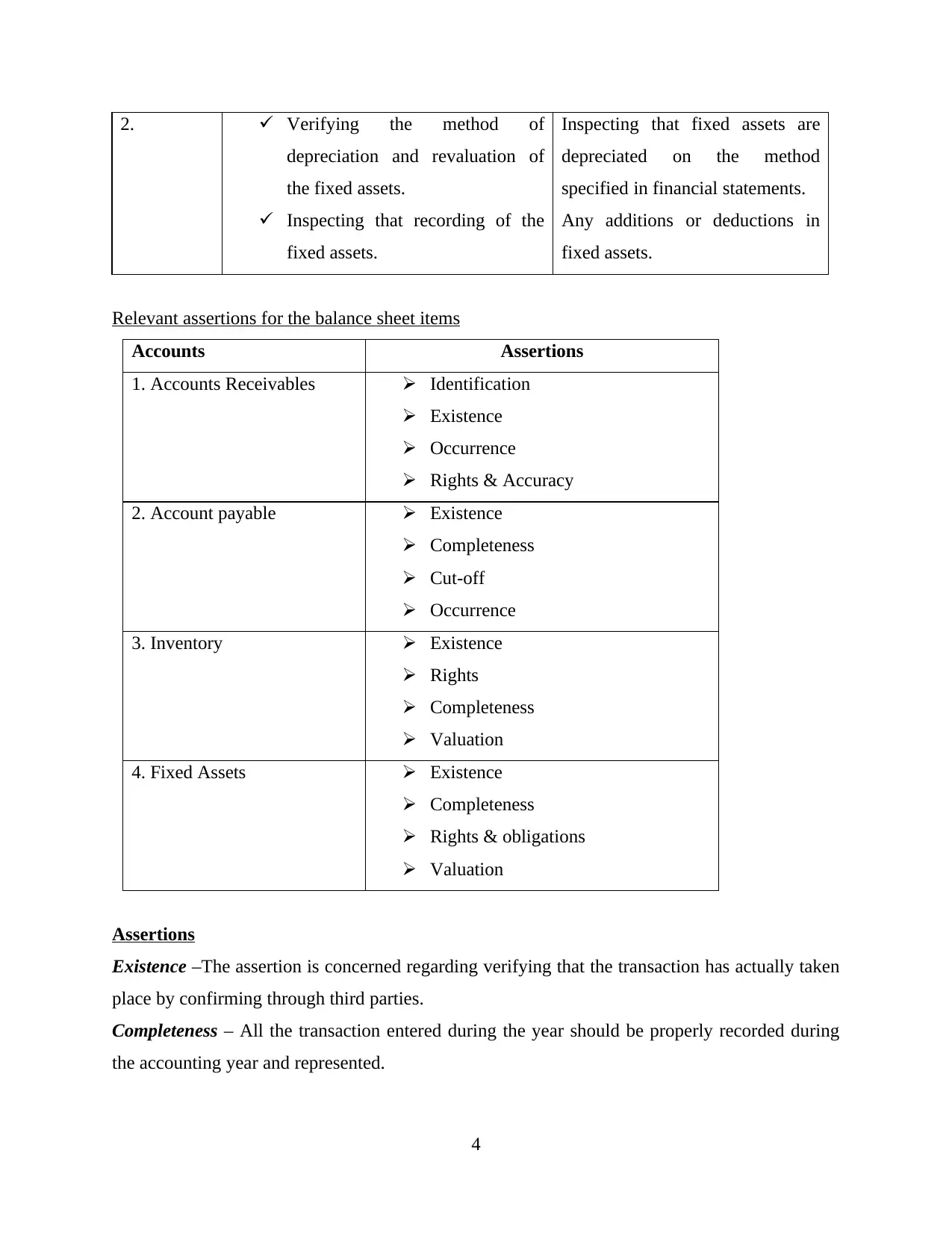
2. Verifying the method of
depreciation and revaluation of
the fixed assets.
Inspecting that recording of the
fixed assets.
Inspecting that fixed assets are
depreciated on the method
specified in financial statements.
Any additions or deductions in
fixed assets.
Relevant assertions for the balance sheet items
Accounts Assertions
1. Accounts Receivables Identification
Existence
Occurrence
Rights & Accuracy
2. Account payable Existence
Completeness
Cut-off
Occurrence
3. Inventory Existence
Rights
Completeness
Valuation
4. Fixed Assets Existence
Completeness
Rights & obligations
Valuation
Assertions
Existence –The assertion is concerned regarding verifying that the transaction has actually taken
place by confirming through third parties.
Completeness – All the transaction entered during the year should be properly recorded during
the accounting year and represented.
4
depreciation and revaluation of
the fixed assets.
Inspecting that recording of the
fixed assets.
Inspecting that fixed assets are
depreciated on the method
specified in financial statements.
Any additions or deductions in
fixed assets.
Relevant assertions for the balance sheet items
Accounts Assertions
1. Accounts Receivables Identification
Existence
Occurrence
Rights & Accuracy
2. Account payable Existence
Completeness
Cut-off
Occurrence
3. Inventory Existence
Rights
Completeness
Valuation
4. Fixed Assets Existence
Completeness
Rights & obligations
Valuation
Assertions
Existence –The assertion is concerned regarding verifying that the transaction has actually taken
place by confirming through third parties.
Completeness – All the transaction entered during the year should be properly recorded during
the accounting year and represented.
4

Rights & obligations – The assertions confirms the rights and obligations of the company
associated with the various transaction entered into regarding receivable or payables.
Occurrence – Assertion is regarding the time on which the transactions are occurred between the
company and third party.
Valuation – Recorded balance of the relevant balance sheet items are truly reflecting the actual
economic value of the items.
Audit Strategy
The strategy adopted for the audit of the company is taken on the basis of the size and
nature of the business. Audit will be reviewing the balance sheet items are free from errors are
material misstatements. Audit is divided into four stages.
Stage1
Determining the suitability and reliability of transactions and underlying available data.
Stage 2
Inspecting the significant differences and doubtful transactions.
Stage 3
Computing all the differences from all the items and errors and misstatements.
Stage 4
Discussion with the management for reasons & resolving the queries and corrections of the
errors and mistakes.
Test Controls
The test of controls will be performed by the audit firm as the company is planning to
change its policies regarding the valuation of inventory at the year end and the change in
estimation of fixed assets. Test of controls will be providing sufficient audience for framing the
opinions regarding the items (Iqbal, 2019). Using test of control auditors will be identifying
effectiveness of controls as the substantive procedures alone may not provide sufficient audit
evidence.
Test of control will provide evidence regarding the management procedures regarding the
approval of transactions related to inventory and fixed assets. Scrutinizing the register of fixed
assets and the valuation method. Standards are followed regarding the recording and valuation of
5
associated with the various transaction entered into regarding receivable or payables.
Occurrence – Assertion is regarding the time on which the transactions are occurred between the
company and third party.
Valuation – Recorded balance of the relevant balance sheet items are truly reflecting the actual
economic value of the items.
Audit Strategy
The strategy adopted for the audit of the company is taken on the basis of the size and
nature of the business. Audit will be reviewing the balance sheet items are free from errors are
material misstatements. Audit is divided into four stages.
Stage1
Determining the suitability and reliability of transactions and underlying available data.
Stage 2
Inspecting the significant differences and doubtful transactions.
Stage 3
Computing all the differences from all the items and errors and misstatements.
Stage 4
Discussion with the management for reasons & resolving the queries and corrections of the
errors and mistakes.
Test Controls
The test of controls will be performed by the audit firm as the company is planning to
change its policies regarding the valuation of inventory at the year end and the change in
estimation of fixed assets. Test of controls will be providing sufficient audience for framing the
opinions regarding the items (Iqbal, 2019). Using test of control auditors will be identifying
effectiveness of controls as the substantive procedures alone may not provide sufficient audit
evidence.
Test of control will provide evidence regarding the management procedures regarding the
approval of transactions related to inventory and fixed assets. Scrutinizing the register of fixed
assets and the valuation method. Standards are followed regarding the recording and valuation of
5
Paraphrase This Document
Need a fresh take? Get an instant paraphrase of this document with our AI Paraphraser

the fixed assets and misstatements. That change will result in better presentation of the
accounting statements
Substantive approach
Substantive will be used for auditing the balance sheet items of the company. However in
depth substantive approach is not required as the internal control system of the company is
strong.
Substantive approach will be followed in verification of the accounts receivable and
accounts payable. This will be confirming transactions in the bank statement and the third party
confirmation random basis. Matching the orders with invoices and cash collections are made
timely. Substantive approach will provide accuracy of various transactions and balances.
Sufficient appropriate audit evidence will be obtained for confirming the balances of accounts
payable.
Substantive testing refers to the audit procedures for examining financial statements for
supporting the documentations. For auditors to frame their opinion it is essential that they obtain
sufficient audit evidence (Rahman, 2019). They are essential for ensuring that the records and the
statements are free from errors and material misstatements.
Audit Team
Auditors Name Audit Education Experience
Lead Auditor Mr Daniels Fixed Assets CPA, Bachelor of
Accounting & Business
18 years
Senior Auditor Mr Robert Inventory CPA, Bachelor of
Accounting
12 years
Senior Auditor Mr Den Accounts Payable CPA, Bachelor of
Business
9 years
Auditor Steven Accounts Payable CPA, Bachelor of
Accounting
3 years
Auditor John Inventory CPA 3 years
Auditor Mark Accounts
Receivables
CPA 4 years
6
accounting statements
Substantive approach
Substantive will be used for auditing the balance sheet items of the company. However in
depth substantive approach is not required as the internal control system of the company is
strong.
Substantive approach will be followed in verification of the accounts receivable and
accounts payable. This will be confirming transactions in the bank statement and the third party
confirmation random basis. Matching the orders with invoices and cash collections are made
timely. Substantive approach will provide accuracy of various transactions and balances.
Sufficient appropriate audit evidence will be obtained for confirming the balances of accounts
payable.
Substantive testing refers to the audit procedures for examining financial statements for
supporting the documentations. For auditors to frame their opinion it is essential that they obtain
sufficient audit evidence (Rahman, 2019). They are essential for ensuring that the records and the
statements are free from errors and material misstatements.
Audit Team
Auditors Name Audit Education Experience
Lead Auditor Mr Daniels Fixed Assets CPA, Bachelor of
Accounting & Business
18 years
Senior Auditor Mr Robert Inventory CPA, Bachelor of
Accounting
12 years
Senior Auditor Mr Den Accounts Payable CPA, Bachelor of
Business
9 years
Auditor Steven Accounts Payable CPA, Bachelor of
Accounting
3 years
Auditor John Inventory CPA 3 years
Auditor Mark Accounts
Receivables
CPA 4 years
6
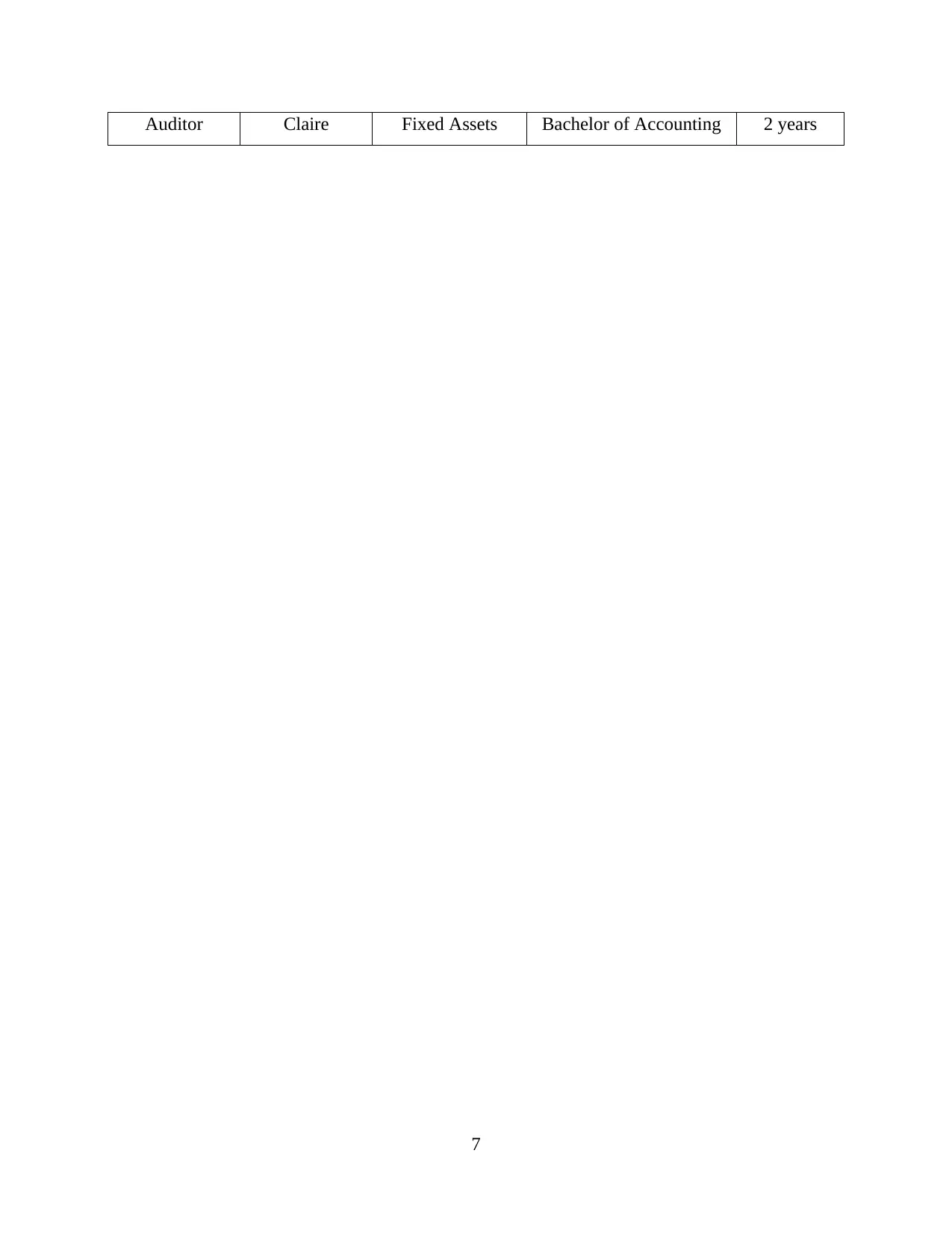
Auditor Claire Fixed Assets Bachelor of Accounting 2 years
7
7
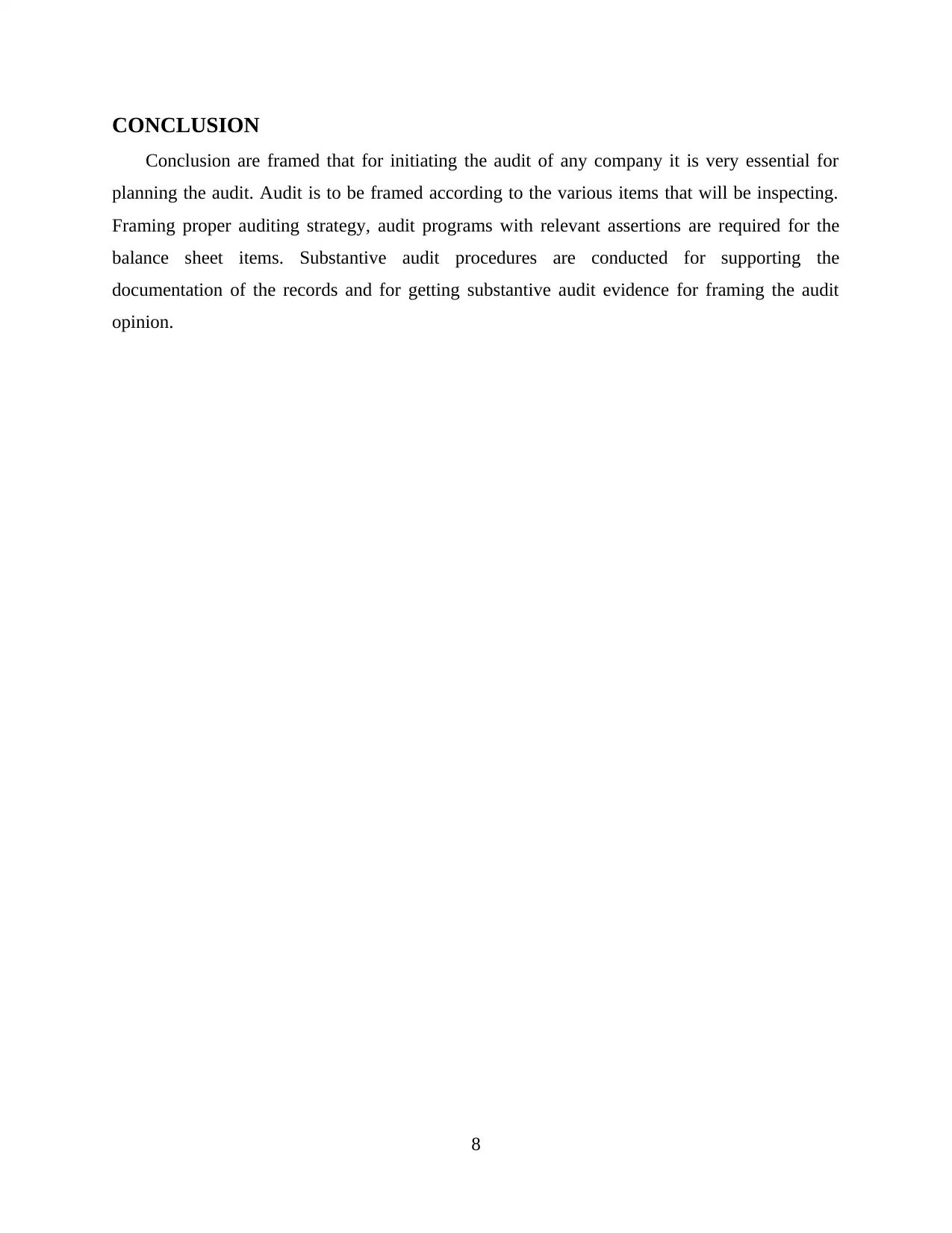
CONCLUSION
Conclusion are framed that for initiating the audit of any company it is very essential for
planning the audit. Audit is to be framed according to the various items that will be inspecting.
Framing proper auditing strategy, audit programs with relevant assertions are required for the
balance sheet items. Substantive audit procedures are conducted for supporting the
documentation of the records and for getting substantive audit evidence for framing the audit
opinion.
8
Conclusion are framed that for initiating the audit of any company it is very essential for
planning the audit. Audit is to be framed according to the various items that will be inspecting.
Framing proper auditing strategy, audit programs with relevant assertions are required for the
balance sheet items. Substantive audit procedures are conducted for supporting the
documentation of the records and for getting substantive audit evidence for framing the audit
opinion.
8
Secure Best Marks with AI Grader
Need help grading? Try our AI Grader for instant feedback on your assignments.
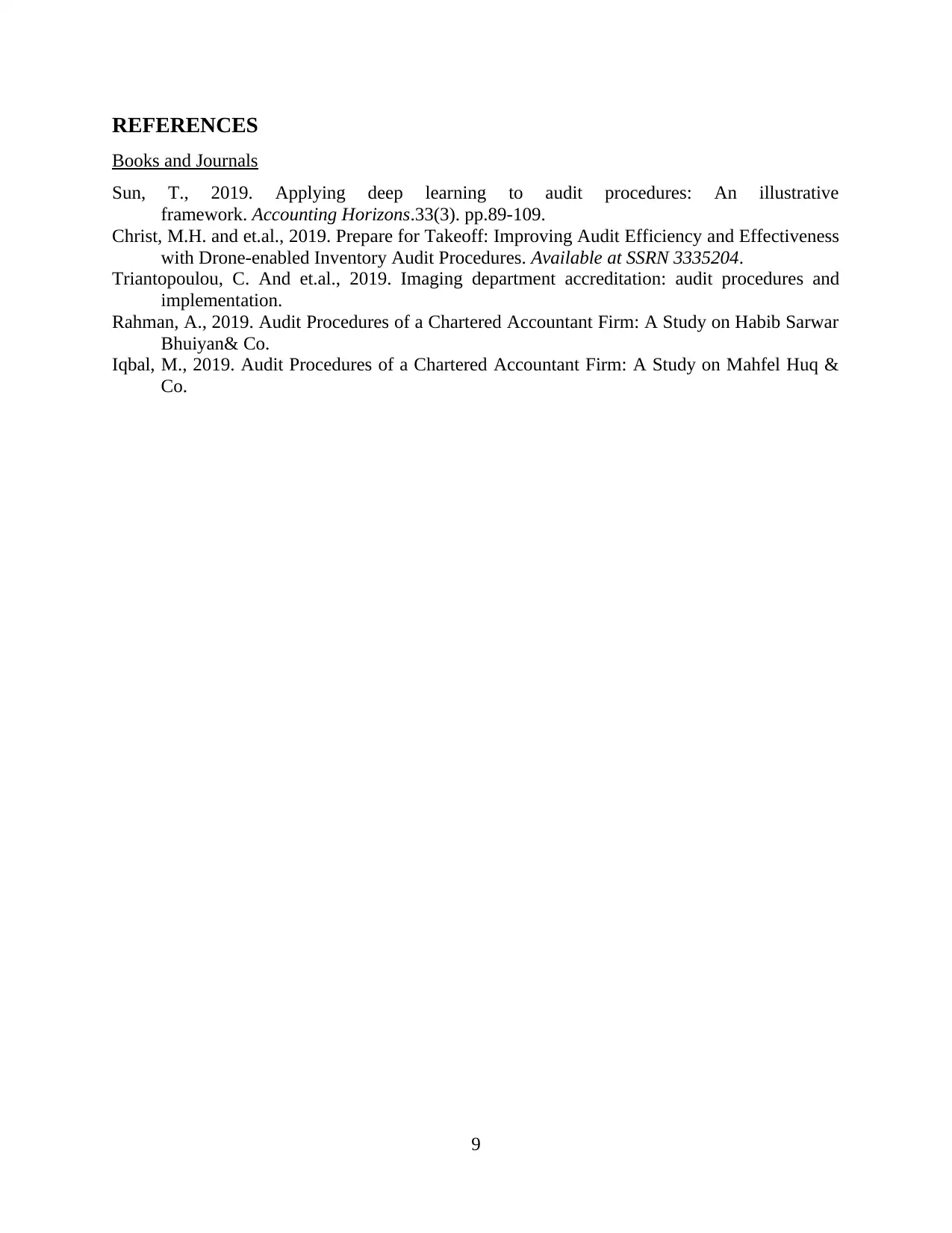
REFERENCES
Books and Journals
Sun, T., 2019. Applying deep learning to audit procedures: An illustrative
framework. Accounting Horizons.33(3). pp.89-109.
Christ, M.H. and et.al., 2019. Prepare for Takeoff: Improving Audit Efficiency and Effectiveness
with Drone-enabled Inventory Audit Procedures. Available at SSRN 3335204.
Triantopoulou, C. And et.al., 2019. Imaging department accreditation: audit procedures and
implementation.
Rahman, A., 2019. Audit Procedures of a Chartered Accountant Firm: A Study on Habib Sarwar
Bhuiyan& Co.
Iqbal, M., 2019. Audit Procedures of a Chartered Accountant Firm: A Study on Mahfel Huq &
Co.
9
Books and Journals
Sun, T., 2019. Applying deep learning to audit procedures: An illustrative
framework. Accounting Horizons.33(3). pp.89-109.
Christ, M.H. and et.al., 2019. Prepare for Takeoff: Improving Audit Efficiency and Effectiveness
with Drone-enabled Inventory Audit Procedures. Available at SSRN 3335204.
Triantopoulou, C. And et.al., 2019. Imaging department accreditation: audit procedures and
implementation.
Rahman, A., 2019. Audit Procedures of a Chartered Accountant Firm: A Study on Habib Sarwar
Bhuiyan& Co.
Iqbal, M., 2019. Audit Procedures of a Chartered Accountant Firm: A Study on Mahfel Huq &
Co.
9
1 out of 11
Related Documents
Your All-in-One AI-Powered Toolkit for Academic Success.
+13062052269
info@desklib.com
Available 24*7 on WhatsApp / Email
![[object Object]](/_next/static/media/star-bottom.7253800d.svg)
Unlock your academic potential
© 2024 | Zucol Services PVT LTD | All rights reserved.





